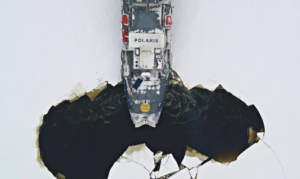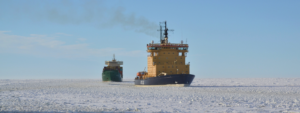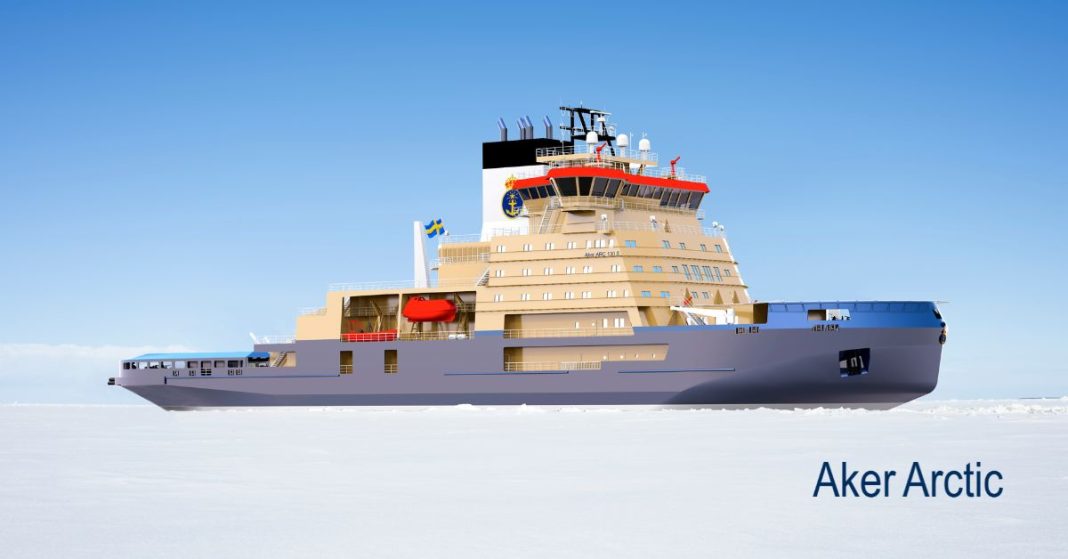The state-of-the-art icebreaker with unrivalled energy efficiency will be the first methanol-ready icebreaker in the world.
The development of the next-generation Baltic assistance icebreaker has progressed to the next phase. The Aker ARC 130 S design has been finalized in close co-operation with the Swedish Maritime Administration (SMA) and optimized for Sweden’s icebreaking needs.
Selection of shipyard
The decision to construct at least two new icebreakers for Sweden was made in December 2022. The first vessel is planned to be delivered in 2026 and the second about a year later.
Currently, SMA is evaluating shipyards which would have the expertise and possibility to build the vessels. This assessment should be ready in February 2023.
“After that, we can send out requests for tenders and continue the dialogue with our shortlist of shipyards,” says Dan Broström, project manager at SMA. “We aim to sign the agreement in September 2023 and begin construction preparations immediately.”
Methanol chosen as fuel
The initial concept was prepared with the possibility of adapting the design for various alternative fuels. After Sweden selected renewable methanol as the future non-fossil fuel of its next-generation icebreakers, the design was finalized to consider the special requirements of methanol fuel and to maximize achievable autonomy time during assistance icebreaking operations.
“Currently, the plan is to build the icebreaker initially for fossil-free renewable diesel oil (hydrotreated vegetable oil; HVO) with readiness to adopt methanol fuel as soon as the technology has matured and fuel availability is secured,” Broström outlines. “The harbour generators will use methanol-based MD97 fuel from the start.”
However, since engine manufacturers are working tirelessly to advance the technology as fast as possible and various bio- and e-methanol plant projects are progressing in Sweden, it might well be feasible to build the icebreakers directly for biomethanol use.
Technical pioneers
The Swedish icebreakers will be the first methanol-ready and potentially the first methanol-fuelled icebreakers in the world. This continues the trend with the Baltic icebreakers as technical pioneers, the previous one being Finnish icebreaker Polaris, the world’s first LNG-fuelled icebreaker.
When the project began, Polaris and two Russian icebreakers, Aleksandr Sannikov and Andrey Vilkitsky, had recently been commissioned, all being part of the Aker ARC 130 family of icebreaker designs developed by Aker Arctic.
“We could benefit from the previous designs and develop them further,” says Mikael Sandström, Master mariner, nautical expert at SMA, who has been in charge of overseeing the technical details.
New hull form
There are multiple specialities which set this icebreaker design apart from its predecessors in addition to the fossil-free fuels.
“The hull form is new and does not correspond to anything built before. The ice resistance is extremely low for an icebreaker of this size which improves fuel efficiency, lowers emissions, and is cost-efficient in use,” Sandström explains.
“The energy storage system will also help to keep engine hours down, minimizing service costs and reducing emissions.”
Channels for Panamax vessels
Cargo vessels arriving to the Baltic Sea are growing in size. Panamax-sized vessels with a breadth of 32 metres are visiting harbours more frequently, requiring assistance during the winter navigating season.
“Shipping lanes on the Bay of Bothnia are rather narrow in winter which means that a Panamax vessel beset in ice could effectively block traffic. We don’t want that to happen,” explains Broström. “At the same time, we cannot afford to use two icebreakers to assist a single ship while numerous others are in need of assistance in our freezing waters. Therefore, one icebreaker has to be able to handle one assisted vessel.”

Accordingly, the new icebreakers will be able to create channels of variable widths up to 32 metres. “We had the chance to try how to make a wide ice channel with a narrower ship hull in full-scale on Polaris, and are confident that all vessels, even wider than 32 metres, will be taken care of,” Sandström adds.
Sharp manoeuvring
The chosen triple-azimuthing propulsion layout, already proven with Polaris, will ensure excellent steering capabilities.
“The manoeuvring will be fast and sharp, which saves time. We will be able to turn 90 degrees and move backwards as fast as forwards, which will enable us to assist large vessels on all sides without delay,” Sandström says.
“Icebreakers are bottom-heavy and roll unpleasantly if not countered with an anti-rolling system. Therefore, this was another important feature for us to add in the design. Cruise ships can have fin stabilizers, but these are not suitable for icebreakers,” he says.
In order to make assistance operations safer, easier and more efficient, special attention was paid to the layout and user-friendliness of towing equipment.
Tests to verify selections
The essential features have been tested in Aker Arctic’s ice laboratory as well as in SSPA’s open water basins in Sweden to compare options and confirm results.
“The competence development has been tremendous for us in Sweden, but I believe also our partners have learned from our constant questions and challenges to established procedures,” Sandström says.
“We are confident that the final design meets all our expectations, and that the vessel will be as successful as we have envisioned. Through the fruitful three-party cooperation work with Aker Arctic and the Finnish Transport Infrastructure Agency we have come up with many ingenious solutions,” he adds.
Close-coupled towing is a common way to escort commercial vessels in the Baltic Sea during winter. For the first time, close-coupled towing tests were performed in model-scale to compare different towing solutions.
State-of-the-art icebreaker
Sandström and Broström are extremely proud of the final icebreaker design and that it will meet future environmental demands.
“Regardless of the fuel we use, the icebreakers have the potential to become completely fossil-free,” they say. “Also, in today’s volatile market, it is good to have two options.”

Equal efficiency in operations will be achieved using either renewable diesel oil (HVO) or methanol sourced from renewable feedstock.
“We are building a state-of-the-art icebreaker which combines the best technical features available today with the best renewable fuels for icebreaking. It will meet today’s and tomorrow’s needs to secure maritime traffic in the Baltic Sea, and will assist in ensuring the supply of goods in both Sweden and Finland,” Broström emphasizes.
STUDY ON FUEL ALTERNATIVES
Aker Arctic has compared various future fuel options for icebreaker use (Read more in their article about concept designs to decarbonize icebreaking.).
“From our research, we concluded that methanol is the most favourable fuel alternative from a technological point of view and provides the longest autonomy time which is crucial in icebreaking activities,” says Chief Designer Tuomas Romu, Aker Arctic Technology. “Other evaluated alternatives such as ammonia and hydrogen have more challenges for icebreaking applications.”
Text: Catarina Stewen












